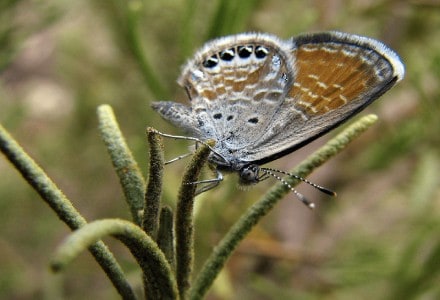
Western Pygmy Blue Facts
- The rather stunning Western Pygmy Blue provides living proof that beauty thrives even amidst great desolation.
- This delicate insect also constitutes one of the smallest butterflies on earth and the smallest known in North America. So: tiny but beautiful.
- The Lepidoptera remains active year-round in the warmest portions of its range. Though its numbers continue to be unclear, the Western Pygmy Blue most likely does not face a threat due to its wide range of habitation.
- The Western Pygmy Blue is a tiny butterfly and living proof that beauty can thrive amidst great desolation.Click To Tweet
Western Pygmy Blue Physical Characteristics
The gorgeous Western Pygmy Blue remains really tiny and possesses an average wingspan of only 1/2 in (1.27 cm). Try spotting that in a field.
The wings typically predominantly display a copper brown in color. The exception is the presence of a large section of each wing closest to the body that is a unique metallic blue.
It also displays white edgings along the borders of the upper portion of the wings. The underside of the wings usually is dotted with small white flecks.
Kingdom: Animalia
Phylum: Arthropoda
Class: Insecta
Order: Lepidoptera
Family: Lycaenidae
Genus: Brephidium
Species: B. exilis
Western Pygmy Blue Habitat, Range, and Ecology
What’s in a name? In this case, the name fits rather perfectly. The Western Pygmy Blue is partly blue, diminutive, and lives primarily along the west coast of the United States.
It will occasionally reach as far north as Oregon as well as in smaller numbers in portions of Mexico and Venezuela.
For reasons that remain unclear, the insect prefers to inhabit areas of desert, wasteland, and salt marshes, though they will venture outward.
The caterpillars also feed on a variety of plant species while the adults feed exclusively on nectar.
Check out our other articles on Julia Heliconian, Venezuelan Poodle Moth, Cabbage White Butterfly, European Earwig, Giant Katydid

